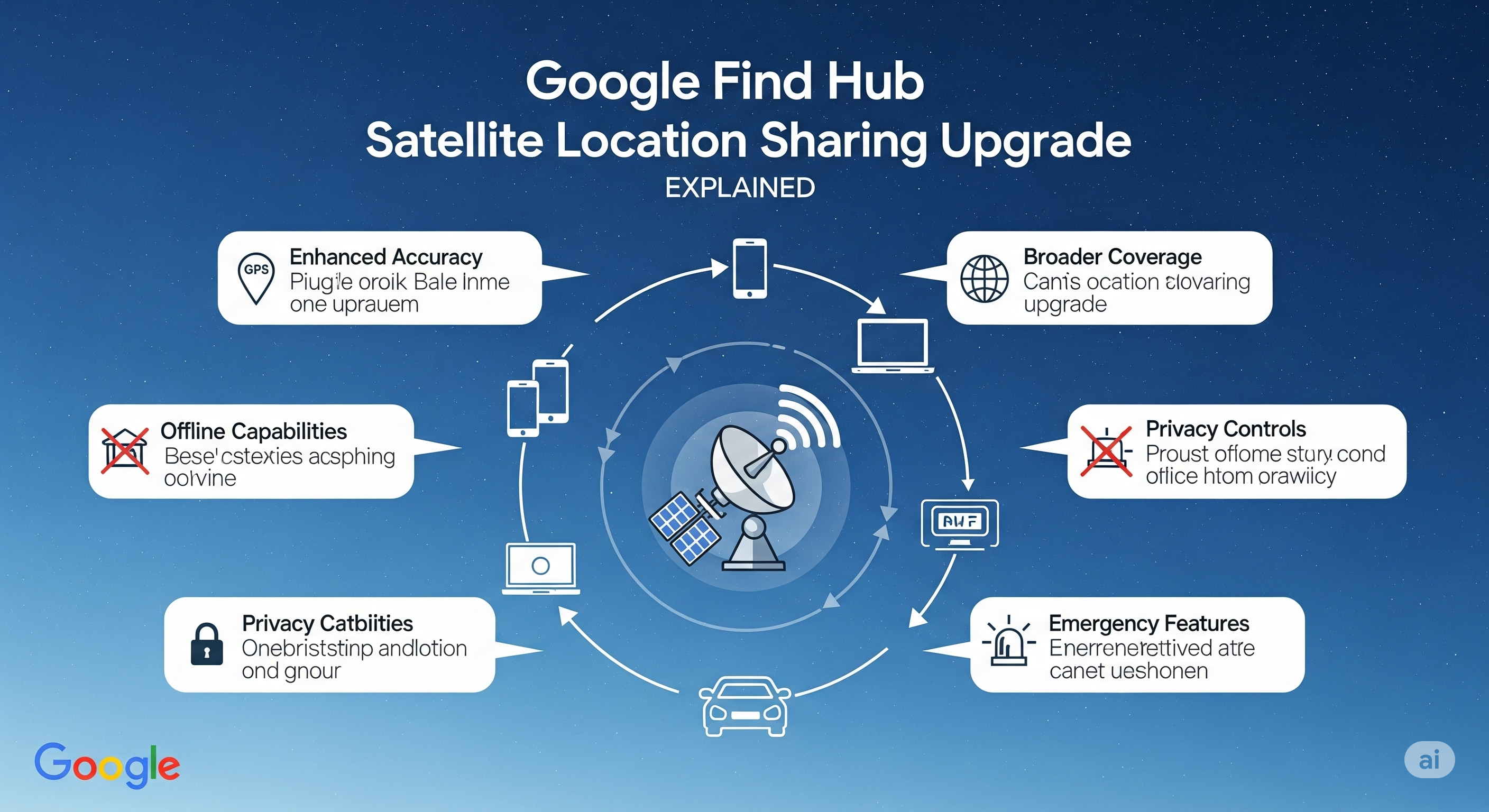Google introduced a new improvement to its Find Hub service. The update is called the Google Find Hub satellite location sharing upgrade. This change is very important because it allows people to share their location even without mobile data or Wi-Fi. Instead of depending only on cell towers, the new system uses satellites to connect and send updates.
This upgrade is designed for safety, travel, and better communication. In this article, we will explain what the service is, how the new feature works, its advantages, possible issues, and why it is a big step for the future of location tracking.
Understanding Google Find Hub
Google Find Hub is a platform that helps people find their devices and share locations with others. It connects with smartphones, smartwatches, tablets, and other gadgets. Earlier, the service mainly used GPS, Wi-Fi, and mobile signals.
The purpose of Find Hub is simple:
- Let users track their devices if they are lost.
- Allow family and friends to see your location if you choose.
- Support safety during travel or emergencies.
Now, with satellite support, Google is making the service more dependable, especially in areas where signals are weak or missing.
What Does the Satellite Upgrade Do?
The satellite upgrade gives Find Hub the ability to share locations through space satellites. Normally, GPS tells your device where you are, but you need mobile or Wi-Fi networks to send that information. This is where problems happen in remote places.
The upgrade solves this issue. Your device can now send location updates directly to satellites. This means you can stay connected in mountains, deserts, forests, or oceans, where towers are not available.
How Does It Function?
The technology may look advanced, but the process is easy for users. Here’s how it works:
- Device Link – Your phone or wearable connects to satellites in low Earth orbit.
- Location Reading – The GPS on your device figures out your position.
- Satellite Transfer – The location is sent directly to the satellite.
- Ground Relay – The satellite sends the data to ground stations.
- Server Update – The data is then shared through Google’s servers to the person you selected.
The user only sees a normal location-sharing screen. But in reality, satellites are ensuring the connection when networks are missing.
Main Features of the Upgrade
The new upgrade brings some special features:
- Worldwide Coverage – Satellites can reach places where mobile towers cannot.
- Emergency Support – You can share your location even during disasters or power cuts.
- Live Tracking – Updates are almost real-time, giving others your exact position.
- Smooth Integration – It works with Android phones, wearables, and other smart devices.
- Simple Use – The system works automatically without complex setup.
Why This Upgrade is Useful
The Google Find Hub satellite location sharing upgrade makes life easier and safer in many ways.
- For Travelers – People hiking, camping, or exploring new regions can stay connected.
- For Families – Parents can keep track of children during school trips or long journeys.
- For Villages – People in rural locations with poor signals can still share their location.
- For Rescue Teams – Emergency workers can find people faster during accidents.
- For Lost Devices – A missing phone in a low-signal area has a better chance of being found.
Security and Privacy
Sharing locations raises privacy questions. Google has included strong protections in this upgrade:
- You control who sees your location.
- All shared data is encrypted before it leaves your device.
- Temporary sharing options let you share your position for a limited time.
- Clear notifications show when location sharing is active.
Even with these protections, users should remain careful. Always turn off sharing when not required to prevent unwanted tracking.
GPS vs. Satellite Sharing
People often think GPS already works everywhere. But the truth is different.
- GPS only finds your location using satellite signals. To share that location, you still need mobile data or Wi-Fi.
- Satellite Sharing not only finds but also sends your location through satellites, without relying on cell towers.
This is why the new upgrade is much more powerful than traditional GPS tracking.
Real-Life Uses
The new feature is not only for emergency situations. It can be very useful in daily life too:
- A family can track members while traveling abroad.
- Friends can share their location while going on a trek.
- Farmers can update their positions from fields without worrying about poor signals.
- Transport companies can follow their trucks in remote routes.
- Tourists can stay safe while visiting forests or beaches.
Possible Drawbacks
Even with advanced technology, there are some challenges:
- Battery Drain – Connecting with satellites takes more power than normal mobile networks.
- Device Support – Only new devices with satellite hardware may be able to use it.
- Costs – Some advanced features might be included in premium plans later.
- Signal Barriers – Places like caves or thick forests may still block signals.
These limitations do not make the feature less important, but users should be aware.
The Future of Google Find Hub
The satellite upgrade is only the first step. In the coming years, we may see:
- Short emergency voice messages via satellite.
- Wider integration with Internet of Things (IoT) devices like cars and drones.
- Full satellite-based internet for sharing more than just locations.
- Automatic alerts in case of accidents or sudden danger.
The growth of this technology can make Find Hub a complete global safety tool.
Why the Upgrade is Important
The world is becoming more connected, but mobile networks still fail in many areas. Travelers, rural families, and rescue workers all need better tools.
The Google Find Hub satellite location sharing upgrade is a major improvement. It gives users confidence that they can stay connected almost anywhere. It improves security, builds trust, and saves time in emergencies.
This is not just a technical update. It represents the future of communication without depending only on mobile towers.
Final Words
The Google Find Hub satellite location sharing upgrade proves how fast technology is growing. By using satellites for sharing positions, Google is solving one of the biggest problems of mobile connectivity.
The benefits are clear: stronger safety, wider coverage, and peace of mind. Even though battery usage, device support, and costs may be challenges, the value it brings is much greater.
In simple words, the upgrade makes sure location sharing works anywhere, anytime. Whether you are in a crowded city or in the middle of a forest, Find Hub will keep you connected.
Google has taken a bold step forward, and this will change the way we think about staying in touch.



